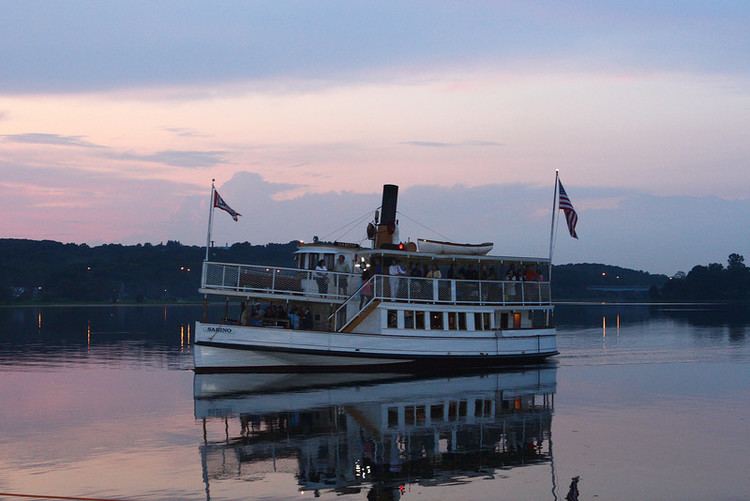Builder W. Irving Adams Beam 21 ft 11 in (6.68 m) Launched 1908 Year built 1908 Added to NRHP 5 October 1992 | Status Museum ship Draft 6 ft 3 in (1.91 m) Length 17 m | |
 | ||
Namesake Abenaki sagamore Sabenoa Installed power Paine compound two-cylinder steam engine | ||
Sabino (pronounced Sah Bye No) is a small, wooden, coal-fired steamboat built in 1908 and currently located at the Mystic Seaport Museum in Mystic, Connecticut. It is one of only two surviving members of the American "mosquito fleet." The vessel was declared a National Historic Landmark in 1992.
Contents
History
Sabino was built in the W. Irving Adams shipyard in East Boothbay, Maine. Originally known as Tourist, the 57-foot vessel was christened on 7 May 1908. Tourist began her career as a ferry for the Damariscotta Steamboat Company on the Damariscotta River in Maine. Tourist sank in 1918 due to an accident, but was salvaged. On 8 October 1921, Tourist was sold to the Popham Beach Steamboat Company on the Kennebec River. The new owners changed the vessel's name to Sabino in honor of Abenaki sagamore Sabenoa.
On 23 July 1927, Sabino was purchased by the Cape Shore Ferry Company in Portland, Maine. Sabino ferried passengers from Portland to the many islands of Casco Bay. Sponsons were added in 1928 to help stabilize Sabino in the open water of Casco Bay. In 1935, Sabino was again sold, this time to the Casco Bay Lines. After a few years, Sabino began to show her age and was put into the company's reserve fleet. Sabino was returned to regular ferry service in 1956, when another ferry ran aground. However, Sabino's usefulness to the Casco Bay Lines was short-lived and in 1958, she was sold to Red Slavit. Shortly thereafter, Slavit sold her to Philip and Irene Corbin of Salisbury, Massachusetts.
The Corbin family then spent a great amount of time repairing the vessel and bringing her up to Coast Guard regulations for a passenger vessel. In 1971, the Sabino was sold to C. Bruce Brown, Joseph Pulvino, and Philip Corbin's son, Jim, doing business as Steamship Sabino Inc. Jim was made part of the corporation because neither Pulvino nor Brown had any practical experience running a steamboat. Brown was an insurance salesman and Pulvino was an aeronautical engineer with the General Electric Company in Lynn, Massachusetts. The Sabino had run on the river a year before but had no licensed captain or engineer. In order for the Sabino to do real business they needed a licensed captain and a licensed engineer. Capt. Dana Terell from Cape Elizabeth, Maine was hired as the Captain of the Sabino. Pulvino approached the Commander of the US Coast Guard in Boston and asked for a license. He was told that experience was needed as a seaman in the engine room. Pulvino explained the situation and it was agreed that if he could pass the examination to be a marine engineer the Commander would issue a license limited to the Sabino. Pulvino passed the exam along with his mentor, John Clements, and was issued license # 1,1 limited to the Sabino. The Sabino began operating from Newburyport on the Merrimack River on Memorial Day, running between Newburyport and the Black Rocks in Salisbury Beach in one direction, and Newburyport and Merrimack, Mass in the other direction. On extreme high tides the Sabino would make it all the way to Haverhill. In 1972, Jim Corbin was bought out of Steamship Sabino Inc. Sabino operated both day and nighttime jazz cruises on the Merrimack River until 1974 when Sabino was leased/purchase for one year to the Mystic Seaport Museum to determine if a steamboat would appeal to the museum's patrons. The ocean voyage between Newburyport and Mystic Seaport was almost the demise of the Sabino. She hit large waves on the trip which stirred up all the dormant coal from the bilge and blocked the onboard bilge pumps, causing the engine room to fill with water. Luckily, Joe had "borrowed" a large gasoline powered pump from the Newburyport Fire Dept and that was used to keep the Sabino afloat. She limped into the Groton Naval Yard to be immediately pulled from the water. On that trip was Joe Pulvino, engineer and owner, C Bruce Brown, owner, Capt Dana Terell, Master, Maynard Bray and another person from Mystic Seaport Museum. The Mystic Seaport shipyard experts recalked her bottom and she entered Mystic Seaport Museum with all the fanfare accorded an ancient steamship! Sabino became a popular attraction, prompting the museum to purchase the vessel. Under the museum's care, Sabino received a complete make over and was brought back to her former glory. In 1992, Sabino received designation as a National Historic Landmark. Sabino is noted as one of the few National Historic Landmarks that a person can ride.
Operation
Sabino is operated by a captain, one or two engineers, and two deck hands. The captain does not directly control the direction or speed of the vessel. Instead, the captain relays his commands through a sequence of bells and gongs to the engineer, who controls the engine. Sabino has an average speed of 8 knots (15 km/h; 9.2 mph) and will consume 60 tons of coal annually. It is estimated that Sabino carries approximately 33,000 passengers per year.
Current status
Issues with the boiler: Sabino will be dockside until these issues are resolved: https://c1.staticflickr.com/1/103/315832518_6fd4c61d1e_z.jpg?zz=1 Sabino currently operates regularly at the Mystic Seaport giving patrons tours of the Mystic River.
